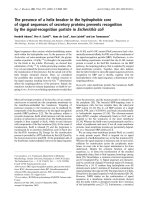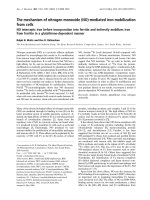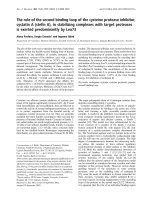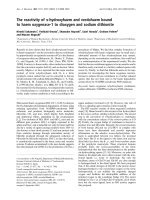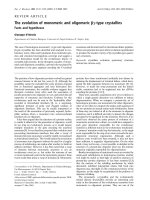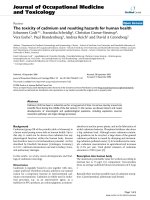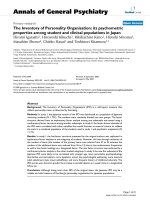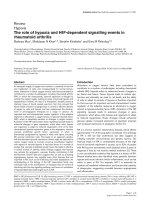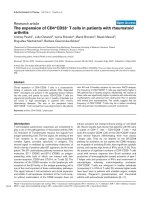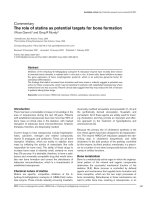Báo cáo y học: " The development of a knowledge test of depression and its treatment for patients suffering from non-psychotic depression: a psychometric assessment" ppt
Bạn đang xem bản rút gọn của tài liệu. Xem và tải ngay bản đầy đủ của tài liệu tại đây (267.37 KB, 15 trang )
BioMed Central
Page 1 of 15
(page number not for citation purposes)
BMC Psychiatry
Open Access
Research article
The development of a knowledge test of depression and its
treatment for patients suffering from non-psychotic depression: a
psychometric assessment
Adel Gabriel*
1
and Claudio Violato
2
Address:
1
University of Calgary and Calgary Health region, 2000 Pegasus Rd NE, Calgary AB T2E 8K7, Canada and
2
Department Community
Health Sciences, Faculty of Medicine, University of Calgary, 3330 Hospital Drive NW, Calgary AB T2N 4N1, Canada
Email: Adel Gabriel* - ; Claudio Violato -
* Corresponding author
Abstract
Background: To develop and psychometrically assess a multiple choice question (MCQ)
instrument to test knowledge of depression and its treatments in patients suffering from
depression.
Methods: A total of 63 depressed patients and twelve psychiatric experts participated. Based on
empirical evidence from an extensive review, theoretical knowledge and in consultations with
experts, 27-item MCQ knowledge of depression and its treatment test was constructed. Data
collected from the psychiatry experts were used to assess evidence of content validity for the
instrument.
Results: Cronbach's alpha of the instrument was 0.68, and there was an overall 87.8% agreement
(items are highly relevant) between experts about the relevance of the MCQs to test patient
knowledge on depression and its treatments. There was an overall satisfactory patients'
performance on the MCQs with 78.7% correct answers. Results of an item analysis indicated that
most items had adequate difficulties and discriminations.
Conclusion: There was adequate reliability and evidence for content and convergent validity for
the instrument. Future research should employ a lager and more heterogeneous sample from both
psychiatrist and community samples, than did the present study. Meanwhile, the present study has
resulted in psychometrically tested instruments for measuring knowledge of depression and its
treatment of depressed patients.
Background
Many people who have personal experience with depres-
sion cannot recognize it in vignettes, can't differentiate
depression from normal sadness [1], their knowledge
about its causes is distorted and over half of the subjects
who have major depression (MD) do not seek treatment
for the episode [2-4]. Moreover, only 40% consider anti-
depressants to be helpful [2], few recommend treatment
from a counselor, telephone service or psychologist, and
many consider a psychiatrist as harmful [3]. There is, how-
ever, emerging evidence to suggest that mental health lit-
eracy can be improved with educational interventions
[5,6].
If the public's mental health literacy is not improved, pub-
lic acceptance of evidence-based mental health care may
Published: 15 September 2009
BMC Psychiatry 2009, 9:56 doi:10.1186/1471-244X-9-56
Received: 23 January 2009
Accepted: 15 September 2009
This article is available from: />© 2009 Gabriel and Violato; licensee BioMed Central Ltd.
This is an Open Access article distributed under the terms of the Creative Commons Attribution License ( />),
which permits unrestricted use, distribution, and reproduction in any medium, provided the original work is properly cited.
BMC Psychiatry 2009, 9:56 />Page 2 of 15
(page number not for citation purposes)
be hindered. There is still much to be done to provide an
empirical basis for evidence-based interventions to reduce
misconceptions about mental illness and to improve atti-
tudes toward people with mental illness [7,8].
Educational studies should include the appropriate meas-
ures to evaluate the effectiveness of psycho educational
interventions. Some researchers have developed instru-
ments to examine patient's knowledge of mood disorders
and its treatments. Kronmüller et al., for example, devel-
oped the Knowledge about Depression and Mania Inven-
tory (KDMI) in German, which demonstrated evidence
for predictive prognostic validity [9,10]. Nonetheless,
there are no strictly objective instruments (e.g., multiple
choice questions - MCQ) readily available in English to
assess knowledge of depression and its treatments in
patients suffering from depression. There is, therefore, an
urgent need to develop materials and methods to teach
depressed patients, and reliable and valid instruments to
measure and assess patients' knowledge of depression.
The major purpose of the present study was to develop
and psychometrically assess an MCQ instrument to meas-
ure patients' knowledge of depression. A number of
themes about patients' and the public's lack of knowledge
of depression emerge and are summarized below.
Recognition of Depression and Helpful Professionals
Many people are not able to identify depression correctly
in community surveys or structured interviews of both
adolescents and adults [2-4,11-13]. In these studies,
respondents were also misinformed about the causes of
depression, were not able to differentiate major depres-
sion from normal sadness, and were unlikely to seek pro-
fessional help for depression [12-17]. In a vignette
depicting a depressed person, for example, only 39% of
respondents (n = 1 010) correctly identified the case as
depression. Moreover, only 51% rated a psychiatrist as
helpful from a list of various professionals that could be
either helpful or harmful for the person described in the
vignette [11]. Many standard psychiatric treatments (anti-
depressants, antipsychotics, electroconvulsive therapy,
and admission to a psychiatric ward) were more often
rated as harmful than helpful, and some nonstandard
treatments (increased physical or social activity, relaxa-
tion and stress management, reading about people with
similar problems) were rated as more helpful [11].
Knowledge about the Causes of Depression
There are many imprecise beliefs about the causes of
depression among both patients and the public, which
appear to influence the perceptions of the effectiveness of
treatments. In a number of studies [14-16] there is evi-
dence to suggest that, especially among poorly educated
people, there is an enduring belief system that depression
is primarily caused by psychosocial stresses such as occu-
pational and family stressors or by weakness of character
or losing self-control. In the study by Lauber, Falcato,
Nordt and Rossler, for example, only 14.1% of partici-
pants (n = 873) attributed symptoms to depression when
presented with a vignette depicting a man with depressive
symptoms, while more than half considered family diffi-
culties, occupational difficulties, or other traumatic fac-
tors as the main causes for the symptoms [15]. Poor
knowledge of the causes of depression and its biological
aspects is widespread in patients with depression [17-19].
Knowledge of Depression and its Causes Influence
Treatment Choices
A number of studies have shown that imprecise knowl-
edge of depression and its causes negatively influence the
decision of treatment choices. In a community survey (n
= 3 010), for example, although people with personal
experience of depression viewed depression as more disa-
bling than other medical conditions, 40% of those with
major depression considered antidepressants harmful
[2,14]. Psychiatrists are frequently viewed as not very
helpful for depressed patients [2,3,14,20-23]. Many peo-
ple with depression frequently turn to the lay support sys-
tem first, followed by the family physician if the former
fails to help [24]. Some studies have found that correct
recognition of depression and attribution to biological
causes is associated with a positive attitude toward psy-
chopharmacology [11,12,17,18,25,26].
Poor Knowledge of and Negative Attitudes to Depression
Influence the type of Help-Seeking
It was reported that 55% of subjects who fulfilled the
Research Diagnostic Criteria of Major Depression did not
seek help [4]. The non-help seekers did not consider the
episode serious or recognize it at as an illness and believed
that they could handle the episode themselves. On the
other hand, those who sought help felt that their experi-
ence of the episode was too painful, lasted too long, and
disrupted their interpersonal and role functioning [4]. A
number of studies have shown that the most frequently
endorsed reasons for depressed people delaying or not
seeking professional help or treatment was related to lack
of knowledge about mental illness and available treat-
ments [4,12,27,28]. People who have poor knowledge of
depression are less likely to recommend treatment from a
counselor, psychologist, or a psychiatrist than those who
had better knowledge - some with poor knowledge con-
sider psychiatrists to be harmful [3,24].
Most of the community and patient studies have relied on
vignettes, anecdotes or case studies for assessing respond-
ents' knowledge of depression and other mental health
conditions. There are no studies that used reliable and
valid instruments to objectively and comprehensively test
BMC Psychiatry 2009, 9:56 />Page 3 of 15
(page number not for citation purposes)
the patient's knowledge of depression such as multiple
choice question (MCQ) instruments. Vignettes were the
most commonly used methods in various studies and sur-
veys to assess recognition of depression by both patients
[23-26] and the public [29-32]. There is, therefore, an
urgent need for reliable and valid instruments to assess
knowledge of depression by patients and the general pub-
lic. Accordingly, the major purpose of the present study
was to develop and psychometrically assess an instrument
for measuring knowledge of patients suffering from
depression.
Method
Participants
Patients
A total of 63 consenting, stable depressed patients and
twelve psychiatric expert volunteers participated. The 63
patients, both men and women, ranged from 18 to 65
years of age (mean = 43 years). All participants were
treated as outpatients following referrals by their family
physicians. The "Mini-International Neuropsychiatric
Interview" (MINI screen 2001-2005) was used to confirm
the diagnosis of major depressive or dysthymic episodes
[33]. Patients were included if they had at least one epi-
sode of major depression, dysthymia, or bipolar depres-
sion. All patients were clinically stable (i.e. not acutely
depressed or exhibiting suicidal ideation, and those who
scored less than 4 on the Hamilton Rating Scale for
Depression (HAM-7) [34].
All patients were on antidepressant medication, and all
had seen their clinicians on at least two occasions for
standard treatment and standard psycho-education as a
part of standard clinical care prior to recruitment. Patients
with chronic or recent alcohol and illicit drug abuse,
patients suffering from psychotic symptoms, and patients
suffering from all degrees of mental handicap, were
excluded from the study.
Psychiatry Experts
Both male and female experts in mood disorders were
invited to participate in the present study (n = 12, female/
male = 2/10, mean age = 52 years; SD = 11.6, and mean
years of experience as independent consultants = 22; SD =
12.5). There were nine at the rank of professor, two at
associate professor, and one at assistant professor. Each
expert reviewed and provided comments on the relevance
of the instrument to be developed before testing the
instruments with patients suffering from depression.
Three experts were invited for an informal panel discus-
sion of the instrument, and reviewing the individual items
in depth. Each of the remaining nine experts was invited
to formally rate each item for its relevancy in testing
depression knowledge and its treatment on a five point
Likert scale.
The conjoint scientific and ethics board of the University
of Calgary granted approval for the study.
Procedures
The design involved the development and the psychomet-
ric assessment. A table of specification (Table 1), with the
initial items was created to guide the question construc-
tion (items = 27), on three levels of cognitive outcomes:
knowledge, comprehension, and application [35]. The
initial items of the table of specification were developed
based on empirical evidence from an extensive review of
literature, theoretical knowledge, and in consultations
with national and international psychiatry experts. The
instrument items were divided into the following five sub-
scales: Definition (5 items), risk of relapse (2 items), eti-
ology (2 items), presentation and symptoms (6 items),
and biological and psychological treatments (12 items).
The MCQ items (Appendix A) were written following
basic rules for item construction so as to avoid common
technical item flaws [36,37]. A volunteer panel of experts
met on three occasions to review the items for the follow-
ing: 1) appropriateness of difficulty and relevancy for
patients as examinees, 2) concise, clear language at the
appropriate level (Grade 9) and was as much as possible
without medical or psychiatric jargon, 3) each requires
patient knowledge to be demonstrated in a specific area of
depression or its treatment, and 4) at least three experts
agreed on the correct answer for each question.
The remaining nine experts were asked to rate the rele-
vance of each MCQ in sampling patient knowledge of
depression and its treatment on a 5-point Likert scale
(from 1 = irrelevant to 5 = highly relevant).
Data Collection and Analysis
Responses from psychiatry experts were used to provide
evidence for face and content validity for the instrument,
while patient responses and patient performances on the
instrument were utilized to provide evidence for internal
consistency reliability and convergent validity as pre-
sented in correlation analysis, and factor analysis. For the
patients, each item on the MCQ test was scored correct (1)
or incorrect (0) and then summed for a total score.
Results
The demographics of the patients are described in Table 2.
Most of the sample were women (65%), Caucasian (86%)
and had suffered from depression for a mean number of
8.9 years (SD = 6.3).
The mean score of performance on the MCQs was 21 (SD
= 3.1) with a range 12 - 26. The internal consistency relia-
bility (Cronbach's alpha) was 0.68 for the 27 items on the
MCQ. There were no significant differences between
males and females, in marital status, ethnicity or any dif-
BMC Psychiatry 2009, 9:56 />Page 4 of 15
(page number not for citation purposes)
Table 1: Table of Specifications and Taxonomy of the Cognitive Objectives
Knowledge Objectives KNO
¶
COM
±
APP
†
Total
Definition
The ability to understand that depression is not a weakness of the character, but a medical disorder.
††
Q1 1
The Size of the Problem (Epidemiological facts) Prevalence of depression
Having the correct knowledge about the life time chances of becoming depressed approximately
Q3 1
The risk of suicide
Awareness of the serious facts about the rates of suicide associated with depression
Q2 1
Age of Onset
Recognizing that depression can start in childhood
Q4 1
Sex differences
Recognizing that depression is more common in women than men
Q5 1
Relapse risks of, and triggering factors
Knowledge of the chances of relapse rates after remission
Understanding that sopping antidepressants after recovery may lead to relapse
Q6 Q7 2
Etiology
The knowledge that depression could be predisposing or triggered by multiple Biological and Psycho-social
factors
Q8 Q9 2
Clinical Presentations
Distinction from normal sadness
Awareness that occasional sadness may not be an indication for clinical depressive disorder.
The comprehension that suffering from depression may need more than helping oneself
Recognizing that an important difference from normal sadness that depression may last much longer, without
treatment
Q10 Q11 2
To recognize the common symptoms of clinical depression, Q12 4
Cognitive deficits Q13
Inability to make decisions Q14
Abnormal thought content, cognitive abnormalities, and
Poor energy
Q15
Knowledge of Biological treatments (antidepressants)
Knowledge of the delayed onset of the action of antidepressants Q16 1
Ability to act appropriately to failed response to antidepressants Q17
Q21
2
Ability to act and respond appropriately to positive response to antidepressants Q23 1
Ability to understand the need for maintenance treatment Q25 1
Knowledge of different kinds of treatments Q18 1
Knowledge of the magnitude of therapeutic efficacy of treatments Q20 1
Knowledge of common side-effects Q19
Q24
2
Predicting success of treatment with antidepressants Q26 1
BMC Psychiatry 2009, 9:56 />Page 5 of 15
(page number not for citation purposes)
ferences among occupational groups in the performance
on the MCQ. Nor were there significant correlations
between the duration of depression and the number of
visits to see a psychiatrist, or a counselor, and the perform-
ance on the MCQ scores.
Item Analyses
For the purpose of item analyses (Table 3), patient per-
formance was categorized into the following groups:
1. Low performers, with a score range of 12-16 (n = 6)
2. Average performers, with a score range of 17-21 (n =
22)
3. High performers, with a score range of 22-26 (n = 35)
In Table 3, K refers to the Keyed (correct) response, P is
item difficulty (the percentage of patients who answered
this item correctly), and D is the discrimination index of
ECT knowledge Q22 1
Psychological treatments Q27 1
Total 20 4 3 27
¶
KNO: Knowledge
±
COM: Comprehension
†
APP: Application
††
Q: Question
Table 1: Table of Specifications and Taxonomy of the Cognitive Objectives (Continued)
Table 2: Demographics of Participating Patients (n = 63)
Non-continuous variables Frequency Percentage %
Sex
Men/Women 22/41 35/65
Diagnosis
Major Depression 44 70
Bipolar Depression 14 22
Dysthymia 58
Marital Status
Single 51 24
Married 33 52
Divorced 12 19
Separated 35
Ethnicity
Caucasian 54 86
Non-Caucasian 9 14
Occupation
Professional 14 22
Entrepreneur 7 11
Skilled 26 41
Non-skilled 16 26
Continuous Variables Min/max Mean ± SD
Patient age 19/65 43 ± 11.3
Duration of depression (years) 1/25 8.9 ± 6.3
Duration of the most recent episode (months) 1/20 6.8 ± 3.8
Times of visits over last 6 months 1/10 5 ± 2.4
HAM-D 7 score at enrolment 0/4 2.38 ± 1
BMC Psychiatry 2009, 9:56 />Page 6 of 15
(page number not for citation purposes)
Table 3: MCQ Distribution and Item Analysis of the Knowledge MCQ
Item Percentage of responses for each item Percentage of High and Low Students Responding to Each Option Total
ABCD
Correct Wrong High Low High Low High Low High Low K P D
1 87 13 4 9 95 45 0 36 0 9 B 0.87 0.40
2 51 49 12 18 58 54 16 18 12 9 B 0.51 0.13
3 60 94 4 0 12 81 83 9 0 9 C 0.60 0.80
4 87 13 0 9 91 72 4 18 4 0 B 0.87 0.20
5 89 11 0 0 95 72 4 27 0 0 B 0.89 0.27
665 35 0 0 4 274 3691 36D0.650.47
7 92 8 0 0 0 9 0 18 100 72 D 0.92 0.27
894 6 09090910072D0.940.20
9 84 16 0 9 100 45 0 18 0 27 B 0.84 0.47
10 46 54 41 54 0 18 0 18 58 9 D 0.46 0.67
11 54 46 62 36 37 54 0 9 0 0 A 0.54 0.33
1294 6 0 90 90 010081D0.940.13
13 67 33 20 9 0 0 79 63 0 27 C 0.67 0.33
14 94 6 0 0 0 0 0 18 100 81 D 0.94 0.13
1591 9.5 0 095814 90 9B0.910.13
16 87 13 95 54 4 27 0 0 0 18 A 0.87 0.33
BMC Psychiatry 2009, 9:56 />Page 7 of 15
(page number not for citation purposes)
1795 5 4 095900 00 9B0.950.00
18 91 9.5 0 0 0 9 0 18 100 72 D 0.91 0.20
19 67 33 8 54 4 0 4 18 83 27 D 0.67 0.67
20 87 13 4 9 0 0 0 18 95 72 D 0.87 0.13
21 91 9 100 100 0 0 0 0 0 0 A 0.91 0.07
22 33 67 8 18 4 27 50 9 37 45 C 0.33 0.40
23 98 2 0 0 100 100 0 0 0 0 B 0.98 0.00
24 38 62 0 9 70 18 12 36 16 36 B 0.38 0.53
2592 8 0 90 90 910072D0.920.20
26 89 11 4 18 0 0 0 18 95 63 D 0.89 0.20
27 87 13 0 9 0 0 100 63 0 27 C 0.87 0.27
K, Key (correct) Response; P, Difficulty Index; D, Discrimination Value
A, B, C, & D: Response choices to each possible answer for each item in the High and Low performer groups.
Discrimination values are identified as follows;
0. 5 1.0 High discrimination (items n = 4)
0.3 0.5 Moderate discrimination (items n = 7)
0.1 0.3 Some discrimination (items n = 13)
< 0.1 Poor discrimination (items n = 3)
Table 3: MCQ Distribution and Item Analysis of the Knowledge MCQ (Continued)
BMC Psychiatry 2009, 9:56 />Page 8 of 15
(page number not for citation purposes)
the item (how well this item distinguished between the
poor and the high performers on the MCQ test):
P
h
represents the proportion of patients in the High per-
formance group who answered the item correctly, P
l
repre-
sents the proportion of patients in the Low performance
group who answered the item correctly, and n is the
number of all patients who tried this item (Table 3). There
were no significant differences among the high and the
poor knowledge-performers in the three groups for age,
durations of illness, the duration of the current episode,
and the number of visits with a psychiatrist over the last
six months.
Experts' Responses
The expert rating of the relevance of each item for meeting
the objective of measuring and testing patient knowledge
of depression is summarized in Table 4. Items were rated
as follows: 1 as irrelevant, 2 as slightly relevant, 3 as mod-
erately relevant, 4 as significantly relevant, and 5 as highly
relevant. There were no significant differences in ratings
among experts based on their length of experience. There
was an overall agreement (88%) among experts about the
relevance of the MCQs to test patient knowledge on
depression and its treatments. The majority of the items
were rated as highly or significantly relevant (mean = 4.4,
SD = 0.67, range = 1-4).
There was significant positive relationship (r = 0.35, p <
0.01; r = 0.33, p < 0.05), between having the necessary
knowledge about the risks of relapse (subscale #2) and
being aware of the symptoms of depression (subscale #4),
on the one hand, and having knowledge of different bio-
logical and psychological treatments (subscale #5),
respectively. It could be concluded that when patients
understand the causes of depression, they will be able to
think of treatment options more rationally. There was also
positive correlation (r = 0.30, p < 0.05; r = 0.27, p < 0.05)
between subscale 5 'understanding biological and psycho-
logical treatments', and subscale 3' knowledge of etiology
and triggers of depression, and subscale 4, 'knowledge of
symptoms' respectively.
Reliability
The total test had an internal consistency of 0.68 and
although internal consistency for subscales #3, #4 and # 5
were 0.70, 0.44, and 0.61, subscale #1 (items = 5) and
subscale #2 (items = 2) have a much lower internal con-
sistency of 0.11 and 0.32. Some of the items in these two
subscales (items = 7), however, have good discriminating
values that ranged from 0.40 to 0.80 in three out of the
seven items. The low reliability is due to the poor variabil-
ity among the individual scores on the items within these
subscales.
Factor Analysis
Principal component analysis applied on the 27 MCQs
item collected from the psychiatric out-patient setting
revealed seven principal components that explain 57.6%
of the variance related to patient's responses on knowl-
edge about depression and its treatments (Table 5).
Component 1: The Presenting Profile
This component consists of 5 items, has an internal con-
sistency of 0.79 and explains 15.7% of the observed vari-
ance. This component refers to the knowledge of the
antidepressants and their delayed action, especially in
patients with significant symptoms, such as melancholic
features and cognitive impairments.
Component 2: Etiology
This component consists of 6 items, has an internal con-
sistency of 0.33, and explains 9.5% of the observed vari-
Discrimination D==
−P
h
P
l
n
Table 4: Expert Agreement, Patient Responses and the Reliability of the MCQ Knowledge Subscales
Knowledge Subscales Items Expert's Agreement (%) Reliability Cronbach's Patients' Correct Responses (%)
1. Definition, the size of the problem 5 80 0.11 75
2. Risks of relapse 2 97 0.32 75
3. Etiology, causes, and triggers of
depression
2 91 0.70 86
4. Presentation and symptoms 6 86 0.44 77
5. Biological and psychological
treatments
12 86 0.61 81
Overall Content Validity & Reliability 27 88 0.68 78.8
BMC Psychiatry 2009, 9:56 />Page 9 of 15
(page number not for citation purposes)
Table 5: Rotated Factor Matrix for the MCQ Instrument*
Component Loadings
Items C1 C2 C3 C4 C5 C6 C7
1. Which of the following statements about the speed of response to the treatment with antidepressants is
FALSE?
.75
2. Which of the following about sex differences in depression is true? .75
3. All of the following are recognized symptoms of depression EXCEPT: .73
4. Which of the following is true about the age of onset of depression? .69
5. All of the following are typical of patients suffering from clinical depression EXCEPT: .64 .43
6. What are the lifetime chances of becoming clinically depressed? .75
7. Which is FALSE about the response to treatment with antidepressants? .63
8. What factors may trigger the onset of clinical depression? .61
9. Depression may be triggered by all the following EXCEPT .50
10. Which of the following statements about clinical depression is False? .49
11. If medication does not improve depressive symptoms, one should: .78
12. Which is FALSE about the effectiveness of antidepressant medications? .75
13. Which of the following behavior is associated with poor outcome? .67
14. Which is NOT a common symptom of clinical depression? .44
15. Which of the following is NOT a symptom of clinical depression? .42
16. Psychotherapy can help many people with depression. Which of the following statements about
psychotherapy is FALSE?
.87
17. Which is FALSE about selecting the right antidepressant, for someone with depression? .44 .68
18. Which is NOT a recognized treatment for clinical depression? .73
19. The following symptoms are indications of clinical depression EXCEPT: .57
20. Which of the following is FALSE about the relapse of clinical depression? .47
21. What should one do if one's first antidepressant medication fails? .46
22. What is the risk of dying by suicide among depressed patients? .59
23. Which is NOT true about the differences between depression and a passing blue mood? .57
24. If one feels better during the course of treatment, one should .48
25. Which is NOT a common occurrence during treatment with antidepressants? .82
BMC Psychiatry 2009, 9:56 />Page 10 of 15
(page number not for citation purposes)
ance. This component refers to the fact that despite that
the lifetime chances of becoming clinically depressed is
high and that there are many life stresses that can trigger
depression, there is hope for recovery with treatment
using antidepressants.
Component 3: Symptoms' Response to Treatments
This component consists of 6 items, has an internal con-
sistency of 0.60, and explains 8.2% of the observed vari-
ance. This component refers to the knowledge about the
expected patient's behavior in order to achieve clinical
response and improvements in symptoms, and better
prognosis.
Component 4: Psychotherapy
This component consists of 2 items, has an internal con-
sistency of 0.64, and explains 7% of the observed vari-
ance. It refers to correct knowledge about psychotherapy
and the challenges associated with selecting the right anti-
depressant for a particular patient.
Component 5: Subtle Symptoms of Relapse
This component consists of 2 items, has an internal con-
sistency of 0.46, and explains 6.2% of the observed vari-
ance. This component refers to the knowledge about the
risk factors and symptoms associated with relapse of the
illness.
Component 6: Challenges to Adherence
This component consists of 4 items, has an internal con-
sistency of 0.13, and explains 5.4% of the observed vari-
ance. This component refers to the patients' ability to
recognize the normal from the abnormal mood states and
what is expected from them to do when they feel
depressed or when antidepressants fail.
Component 7: Biological Treatments and its Side-effects
This component consists of 3 items, has an internal con-
sistency of 0.51, and explains 5.2% of the observed vari-
ance. It refers to the awareness of the common side-effects
of antidepressants and the efficacy of electro-convulsive
treatment.
Discussion
The main findings of the present study are: 1) psychiatry
experts have a high agreement on the content of an MCQ
test of depression and on the relevance of specific items
thereby adducing evidence of content validity, 2) Cron-
bach's alpha of the instrument was 0.68 indicating ade-
quate reliability, 3) item analysis indicated that most of
the items were working well producing appropriate diffi-
culties, discrimination, and distracter effectiveness, and 4)
the patients performed, overall reasonably well on the
MCQ test.
While the total test had adequate reliability, two subscales
did not. Reliability of these subscales can be improved by
decreasing the difficulty of some items (e.g. item # 3) for
which performance was poor in both the high and the low
groups and to increase the difficulty of some of the very
easy items (items #4 and #5), thus increasing the variance
and leading to improve internal consistency reliability.
Future research might also focus on test-retest reliability.
Evidence for Content Validity
This is supported by two main factors. First, the MCQ test
was initially developed based on empirical evidence from
extensive literature review, and from consultations with
experts in the field of depression. Second, from assess-
ment of the instrument, there was 88% overall agreement
among experts on the relevancy of its contents to measure
patient knowledge of depression and its treatments with
the means very high (4.4) for highly relevant.
Evidence for Convergent Validity
Evidence of convergent validity exists when there are pos-
itive correlations between subscales as theoretically
expected. The intercorrelation between risks of relapse
(subscale #2) and awareness of the symptoms of depres-
sion (subscale #4), and having knowledge of different
biological and psychological treatments (subscale #5),
provide evidence of convergent validity. Similarly, the
positive correlations subscale 5 'understanding biological
and psychological treatments' and subscale 3' knowledge
of etiology and triggers of depression, and subscale 4,
'knowledge of symptoms' support convergent validity.
26. Which is FALSE about Electric Convulsive Therapy (ECT) for treating clinical depression? .49
27. Which is NOT a common side effect of antidepressant drugs? .45
Internal Consistency Reliability (Alpha) .79 .33 .60 .64 .46 .13 .51
Percent of Observed Variance 15.7 9.5 8.2 7 6.2 5.4 5.2
*Principal Components Extraction, Varimax Rotation with Kaiser Normalization, Rotation Converged in eight iterations
Table 5: Rotated Factor Matrix for the MCQ Instrument* (Continued)
BMC Psychiatry 2009, 9:56 />Page 11 of 15
(page number not for citation purposes)
Also there were positive correlations between the different
subscales.
Patients' Performance on the MCQ Instrument
The majority of patients did generally well on the test
(mean of the test = 78.8%) of patients answered items cor-
rectly). Fully 77% were able to answer questions about
recognizing the symptoms of depression correctly, and
86% answered questions about causes of depression cor-
rectly. This is in contrast to a number of studies showing
that less than 50% of community participants were able to
differentiate depression from normal sadness [13,16].
Other population based surveys have similarly demon-
strated that most respondents attribute the cause of
depression to family or partnership difficulties [15]. Our
present findings are in contrast to published findings that
patients and members of the public failed to recognize
depression in vignettes [2,4,7].
The evidence from previous research indicates that
respondents have poor knowledge about, and negative
attitudes to antidepressants. Medical treatments for
depression were proposed by a minority of respondents,
and only those who are were able to recognize depression
in a vignette [17,20,22]. In the present study, however,
80% of patients gave correct answers to questions about
the treatments especially antidepressants.
Finally, patients in the present study correctly answered
81% of questions about different treatments of depres-
sion. The high performance for the majority of patients on
this instrument could reflect having developed and
administered items, which were relatively easy, to a highly
knowledgeable patient sample. Item analysis seems to
support this conclusion.
Items' Discriminating Power
There were eleven highly discriminating items (D = 0.3 -
1), thirteen slightly discriminating items (D = 0.1 - 0.3),
and three poorly discriminating (17, 21, and 23; D < 0.1)
items. Some of the items, appeared very easy, and their
answers were obvious, thus leading to poor discrimina-
tion between the high- and the low-performing patients
(i.e., MCQ s # 17, 21, 23). For example, #17 stem reads,
"If my medication does not improve depressive symp-
toms, I should ". To the majority of patients the correct
answer was obvious (B), "Talk to a health-care profes-
sional." Reviewing the distracters of this item, option A,
"Stop taking all medication" requires review as it is obvi-
ously inappropriate and undesirable and very easily
excluded. Option D, "Ask friends about what to do"
appears as a good distracter, in that it shows differences
between the high and the low performing groups. None of
the high performers selected this distracter while 9 of the
low performers selected it. Also, the distracters C and D in
items 21 and 23 did not show any discrimination between
the high and the low performing groups. Modifying the
distracters to increase the difficulty level of these items can
make these items more discriminating. Alternatively,
changing the distracters to increase the difficulty level of
these questions can make these items more discriminat-
ing.
There were no significant differences among the high and
the poor knowledge-performers in the three groups with
respect to age distribution, durations of illness, and the
duration of the current episode, and the number of visits
with a psychiatrist over the last six months.
There are limitations of the present study. The sample of
patients was not large, was homogenous and all patients
were recruited from the authors' practice. Future research
should include larger, more heterogeneous samples from
various community clinics. Also the instrument contains
some very easy items leading to poor discriminating
power for these items and the comparative lack of difficult
items. In future research the instrument might include
items assessing other treatment possibilities in depression
such as the preference for psychotherapy for many people
who are clinically depressed.
Conclusion
A reliable and comprehensive MCQ instrument (items =
27), to measure educational domains of knowledge, in
patients suffering from depression was developed. There
is evidence for content and convergent validity for this
instrument as well as internal consistency reliability. In
future research the instrument should be administered to
a lager sample, after reviewing the poor items, and remov-
ing items numbers which proved poorly discriminating.
Competing interests
The authors declare that they have no competing interests.
Authors' contributions
This study is based on an MSc thesis of AG that was super-
vised by CV. Both authors conceived of the study and par-
ticipated in its design and coordination. AG administered
the instruments and collected the data. CV directed and
oversaw the statistical analysis which was conducted by
both authors. Both authors participated in the writing and
revision and approved the final manuscript.
Appendix A: Knowledge of depression MCQ
Test
Instructions: Circle the best answer for each question
1. Which of the following statements about clinical
depression is FALSE?
BMC Psychiatry 2009, 9:56 />Page 12 of 15
(page number not for citation purposes)
a. It is a medical disorder.
b. It is a weakness of character.
c. It is a common psychiatric disorder.
d. It affects both males and females.
2. What is the risk of death by suicide among
depressed patients?
a. The risk is very minimal.
b. The risk is between 15% and 50%.
c. The risk is below 15%.
d. The risk is above 50%.
3. What are the lifetime chances of becoming clini-
cally depressed?
a. One in 1000
b. One in 50
c. One in 3
d. One in 1
4. Which of the following is TRUE about the age of
onset of depression?
a. Depression does not begin in adolescence
b. Depression can start in childhood or adoles-
cence.
c. Depression appears for the first time in middle-
aged people.
d. Depression does not affect young children.
5. Which of the following, about sex differences in
depression is TRUE?
a. Only women get depressed.
b. Clinical depression is more common in women
than men.
c. Clinical depression is more common in men
than women.
d. Only men get depressed.
6. Which of the following is FALSE about the relapse
of clinical depression?
a. The number of previous episodes of clinical
depression increases the chances of subsequent
episodes.
b. After the first episode of clinical depression,
there is an increased risk of a second episode.
c. Maintenance treatment can reduce the chances
of relapse.
d. After recovery, there is zero risk for recurrence.
7. Which of the following behavior is associated
with poor outcome?
a. Taking antidepressant treatments regularly
b. Being involved in talk therapy (psychotherapy)
c. Staying sober
d. Stopping antidepressant medications if feeling
well
8. What factors may trigger the onset of clinical
depression?
a. Biological factors, such as genes
b. Psychological factors such as having marital
problems
c. Social factors such as losing a job
d. All of the above
9. Depression may be triggered by all the following
EXCEPT:
a. Prolonged severe grief over loved ones
b. Taking antidepressants
c. Certain medical conditions
d. The birth of a new baby
10. The following are indications of clinical depres-
sion EXCEPT:
a. Changes in sleep patterns
b. Poor concentration
BMC Psychiatry 2009, 9:56 />Page 13 of 15
(page number not for citation purposes)
c. Frequent crying for no obvious reasons
d. Occasional sadness
11. Which is NOT true about the differences
between depression and a passing blue mood?
a. People with depression can "pull themselves
together"
b. Depression can be much more disabling in day-
to-day functioning.
c. Patients who are clinically depressed look sad.
d. Without treatment, symptoms of clinical depres-
sion can last for weeks, months, or years
12. All of the following are recognized symptoms of
clinical depression EXCEPT:
a. Marked loss of interests.
b. Excessive sleep
c. Loss of energy
d. Good concentration
13. Which of the following is NOT a symptom of
clinical depression?
a. Restlessness
b. Changes in appetite
c. Good decisions making
d. Lack of energy
14. All of the following are typical of patients suffer-
ing from clinical depression EXCEPT:
a. Negative thinking that can lead to self-defeating
or suicidal behavior
b. Mental fatigue and the inability to solve compli-
cated problems
c. Marked forgetfulness
d. Normal memory
15. Which is NOT a common symptom of clinical
depression?
a. Poor motivation
b. Normal energy
c. Guilty thoughts
d. Fatigue
16. Which of the following statements about the
speed of response to the treatment with antidepres-
sants is FALSE?
a. Symptoms improve immediately after treatment
is begun.
b. Many antidepressants may take several weeks to
start to work.
c. It is important to continue taking medication
even if there is initial improvement.
d. Not all symptoms respond to antidepressants at
the same rate.
17. If medication does not improve depressive
symptoms, one should:
a. Stop taking all medication.
b. Talk to a health care professional.
c. Double the pills.
d. Ask friends about what to do.
18. Which is NOT a recognized treatment for clinical
depression?
a. Medication
b. Talk therapy.
c. Light therapy (photo-therapy).
d. Kiekie therapy
19. Which is NOT a common side effect antidepres-
sant drugs?
a. Upset stomach
b. Sleep disturbances
c. Sexual side-effects (e.g. problems with sexual
desire or orgasm)
BMC Psychiatry 2009, 9:56 />Page 14 of 15
(page number not for citation purposes)
d. Feelings of depression
20. Which is FALSE about the effectiveness of anti-
depressant medications?
a. About 30-40% of patients do not respond to the
initial treatment.
b. Moderate symptom improvement may take few
weeks to be achieved in those who will respond.
c. Using more than one antidepressant may be nec-
essary for some patients.
d. Recovery of symptom can be achieved in all
depressed patients
21. What should one do if one's first antidepressant
medication fails?
a. Consult one's doctors
b. Take sleeping pills
c. Drink more alcohol
d. Use magnetic therapy
22. Which is FALSE about Electric Convulsive Ther-
apy (ECT) for treating clinical depression?
a. It is proved to be effective.
b. It is a safe method.
c. It is no longer used for treating depression.
d. It is given under general anesthesia.
23. If one feels better during the course of treatment,
one should
a. Stop taking antidepressant medication.
b. Discuss the course of antidepressants treatment
with doctor.
c. Reduce the antidepressant dose by half.
d. Start a course of herbal treatment.
24. Which is NOT a common occurrence during
treatment with antidepressants?
a. Gaining weight
b. Severe continuous headaches
c. Feeling sleepy
d. Sweating
25. Which is FALSE about the response to treatment
with antidepressants?
a. Up to 80% of people with depression do get bet-
ter with the right medication.
b. Most people with depression need to be treated
for at least six to nine months to prevent relapse.
c. For some people, it is necessary to stay on medi-
cation for long-term maintenance therapy.
d. If the acute depressive symptoms are relieved,
the patient should stop antidepressants.
26. Which is FALSE about selecting the right antide-
pressant for someone with depression?
a. There are no available laboratory tests to guide
doctors' choices for treating clinical depression.
b. Different people have different responses to
antidepressants.
c. Doctors can tailor antidepressants to suit the
symptoms of individual patients.
d. Doctors can always tell beforehand how a per-
son is going to respond to the medication they pre-
scribe.
27. Psychotherapy can help many people with
depression. Which of the following statements
about psychotherapy is FALSE?
a. Both individual and group talk therapy provides
an opportunity to express and discuss thoughts
and feelings with the therapist.
b. Therapy may help to resolve life issues that may
contribute to depression.
c. All depressed individuals benefit from psycho-
therapy.
d. In psychotherapy, negative, and self-defeating
thoughts can be replaced by more positive, realistic
thoughts.
Publish with BioMed Central and every
scientist can read your work free of charge
"BioMed Central will be the most significant development for
disseminating the results of biomedical research in our lifetime."
Sir Paul Nurse, Cancer Research UK
Your research papers will be:
available free of charge to the entire biomedical community
peer reviewed and published immediately upon acceptance
cited in PubMed and archived on PubMed Central
yours — you keep the copyright
Submit your manuscript here:
/>BioMedcentral
BMC Psychiatry 2009, 9:56 />Page 15 of 15
(page number not for citation purposes)
References
1. Highet N, Hickie I, Davenport T: Monitoring awareness of and
attitudes to depression in Australia. Med J Aust 2002,
176(Suppl):S63-8.
2. Fisher L, Goldney R: Differences in community mental health
literacy in older and younger Australians. Int J Geriatr Psychiatry
2003, 18(1):33-40.
3. Blumenthal R, Endicott J: Barriers to seeking treatment for
major depression. Depress Anxiety 1996, 4:273-8.
4. Goldney RD, Fisher LJ, Wilson DH, Cheok F: Mental health liter-
acy of those with major depression and suicidal ideation: an
impediment to help seeking. Suicide Life Threat Behav 2002,
32(4):394-403.
5. Wolff G, Pathare S, Craig T, Leff J: Community knowledge of
mental illness and reaction to mentally ill people. Br J Psychia-
try 1996, 168(2):191-8.
6. Wolff G, Pathare S, Craig T, Leff J: Public education for commu-
nity care: a new approach. Br J Psychiatry 1996, 168(4):441-7.
7. Angermeyer M, Dietrich S: Public beliefs about and attitudes
towards people with mental illness: a review of population
studies. Acta Psychiatr Scand 2006, 113(3):163-79.
8. Jorm A: Mental health literacy. Public knowledge and beliefs
about mental disorders. Br J Psychiatry 2000, 177:396-401.
9. Kronmüller KT, Saha R, Kratz B, Karr M, Hunt A, Mundt C, Backen-
strass M: Reliability and validity of the Knowledge about
Depression and Mania Inventory. Psychopathology 2008,
41(2):69-76.
10. Kronmüller KT, Victor D, Schenkenbach C, Postelnicu I, Backenstrass
M, Schröder J, Mundt C: Knowledge about affective disorders
and outcome of depression. J Affect Disord 2007, 104(1-
3):155-60.
11. Jorm AF, Korten AE, Jacomb PA, Christensen H, Rodgers B, Pollitt P:
Mental health literacy: a survey of the public's ability to rec-
ognise mental disorders and their beliefs about the effective-
ness of treatment.
Med J Aust 1997, 166(4):182-6.
12. Wright A, Harris MG, Wiggers JH, Jorm AF, Cotton SM, Harrigan SM,
Hurworth RE, McGorry PD: Recognition of depression and psy-
chosis by young Australians and their beliefs about treat-
ment. Med JAust 2005, 183(1):18-23.
13. Highet N, Hickie I, Davenport T: Monitoring awareness of and
attitudes to depression in Australia. Med J Aust 2002,
176(Suppl):S63-8.
14. Link BG, Phelan JC, Bresnahan M, Stueve A, Pescosolido BA: Public
conceptions of mental illness: labels, causes, dangerousness,
and social distance. Am J Public Health 1999, 89(9):1328-33.
15. Lauber C, Falcato L, Nordt C, Rossler W: Lay beliefs about causes
of depression. Acta Psychiatr Scand 2003, 418:96-9.
16. Jorm AF, Korten AE, Jacomb PA, Christensen H, Rodgers B, Pollitt P:
Public beliefs about causes and risk factors for depression
and schizophrenia. Soc Psychiatry Psychiatr Epidemiol 1997,
32(3):143-8.
17. Lauber C, Carlos N, Wulf R: Lay beliefs about treatments for
people with mental illness and their implications for
antistigma strategies. Can J Psychiatry 2005, 50(12):745-52.
18. Srinivasan J, Cohen N, Parikh S: Patient attitudes regarding
causes of depression: implications for psychoeducation. Can
J Psychiatry 2003, 48(7):493-5.
19. Henderson J, Pollard C, Jacobi K, Merkel WT: Help-seeking pat-
terns of community residents with depressive symptoms. J
Affect Disord 1992, 26(3):157-62.
20. Benkert O, Graf-Morgenstern M, Hillbert A, Sandmann J, Ehmig SC,
Weissbecker H, Kepplinger HM, Sobota K: Public opinion on psy-
chotropic drugs: an analysis of the factors influencing accept-
ance or rejection. J Nerv Ment Dis 1997, 185(3):151-8.
21. Riedel-Heller S, Matschinger H, Angermeyer M: Mental disorders-
-who and what might help? Help-seeking and treatment
preferences of the lay public. Soc Psychiatry Psychiatr Epidemiol
2005, 40(2):167-74.
22. Lauber C, Nordt C, Falcato L, Rossler W: Lay recommendations
on how to treat mental disorders. Soc Psychiatry Psychiatr Epide-
miol 2001, 36(11):553-6.
23. Angermeyer MC, Matschinger H, Riedel-Heller SG: Whom to ask
for help in case of a mental disorder? Preferences of the lay
public. Soc Psychiatry Psychiatr Epidemiol 1999, 34(4):202-10.
24. Angermeyer M, Breier P, Dietrich S, Kenzine D, Matschinger H: Pub-
lic attitudes toward psychiatric treatment. An international
comparison. Soc Psychiatry Psychiatr Epidemiol 2005, 40(11):855-64.
25. Wrigley S, Jackson H, Judd F, Komiti A: Role of stigma and atti-
tudes toward help-seeking from a general practitioner for
mental health problems in a rural town. Aust N Z J Psychiatry
2005, 39(6):514-21.
26. Wolff G, Pathare S, Craig T, Leff J: Community knowledge of
mental illness and reaction to mentally ill people. Br J Psychia-
try 1996, 168(2):191-8.
27. Thompson A, Hunt C, Issakidis C: Why wait? Reasons for delay
and prompts to seek help for mental health problems in an
Australian clinical sample. Soc Psychiatry Psychiatr Epidemiol 2004,
39(10):810-7.
28. Angermeyer M, Matschinger H: Public attitudes towards psycho-
tropic drugs: have there been any changes in recent years?
Pharmacopsychiatry 2004, 37(4):152-6.
29. Ng S, Martin J, Romans S: A community's attitudes towards the
mentally ill. N Z Med J 1995, 108(1013):505-8.
30. Addison S, Thorpe S: Factors involved in the formation of atti-
tudes towards those who are mentally ill. Soc Psychiatry Psychiatr
Epidemiol 2004, 39(3):228-34.
31. Buizza C, Pioli R, Ponteri M, Vittorielli M, Corradi A, Minicuci N, Rossi
G: Community attitudes towards mental illness and socio-
demographic characteristics: an Italian study. Epidemiol Psichi-
atr Soc 2005, 14(3):154-62.
32. Angermeyer M, Matschinger H, Corrigan P: Familiarity with men-
tal illness and social distance from people with schizophrenia
and major depression: testing a model using data from a rep-
resentative population survey. Schizophr Res
2004, 69(2-
3):175-82.
33. Sheehan DV, Lecrubier Y, Sheehan KH, Amorim P, Janavs J, Weiller E,
Hergueta T, Baker R, Dunbar GC: The Mini-International Neu-
ropsychiatric Interview (M.I.N.I.): the development and valida-
tion of a structured diagnostic psychiatric interview for DSM-IV
and ICD-10. J Clin Psychiatry 1998, 59(Suppl 20):22-33. quiz 4-57
34. McIntyre RS, Konarski JZ, Mancini DA, Fulton KA, Parikh SV, Grigo-
riadis S, Grupp LA, Bakish D, Filteau MJ, Gorman C, Nemeroff CB,
Kennedy SH: Measuring the severity of depression and remis-
sion in primary care: validation of the HAMD-7 scale. CMAJ
2005, 173(11):1327-34.
35. Bloom BS, Engelhart MD, Furst EJ, Hill WH, Krathwohl DR: Taxonomy
of educational objectives: The classification of educational
goals. In Handbook 1: Cognitive domain New York: David McKay; 1956.
36. Case SM, Swanson DB: Constructing written test questions for the basic
and clinical sciences 3rd edition. Philadelphia, PA: National Board of
Medical Examiners; 2001.
37. Haladyna TM, Downing SM: A taxonomy of multiple-choice
item-writing rules. Appl Meas Educ 1989, 2(1):37-50.
Pre-publication history
The pre-publication history for this paper can be accessed
here:
/>pub
